Whether you are a garden lover or a history buff, Connecticut’s many historic gardens offer both inspiration and a unique glimpse into the lives and sensibilities of generations past. With their parterres and pergolas, stately trees and topiaries, perennial borders and old-fashioned kitchen potagers, the meticulously restored gardens in our region span three centuries and represent an array of styles and horticultural trends.
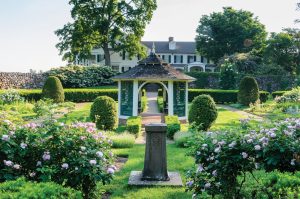
From the early colonial gardens at Stanley-Whitman House to the painterly palette of perennials inspired by the French Impressionists at the Hill-Stead Museum’s Sunken Garden, both in Farmington, much of the flowers and foliage on display at these sites today represent plantings that date back to the gardens’ heydays.
“We try to keep the plants as close as we can to what was there at each garden’s historical peak,” says Laurie Masciandaro, a spokesperson for Connecticut’s Historic Gardens – a consortium of 15 restored properties scattered across the state – and site manager for member Roseland Cottage in Woodstock. Some of the gardens even feature original plantings, like many of the lilacs and heirloom roses that grace the Bellamy-Ferriday estate in Bethlehem, the neatly trimmed boxwoods at Roseland Cottage, and the eponymous Harkness Heliotropes, an antique variety propagated each year from cuttings and then replanted into the East Garden at Harkness Memorial State Park in Waterford.
Each of the properties designated as a Connecticut Historic Garden is associated with an historically significant domicile, so visitors not only get to observe how gardening has evolved over time, but also learn about notable figures from the state’s past – including many influential women – and see how they lived.
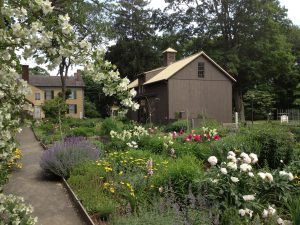
“Women’s history and garden history in Connecticut are intertwined,” says Masciandaro. The women associated with these properties include Florence Griswold, who ran an art colony that nurtured many of the American Impressionists, Theodate Pope Riddle, the country’s first female architect, who designed Hill-Stead, Caroline Ferriday, the prominent socialite and philanthropist.
Whether you are a garden lover or a history buff, Connecticut’s many historic gardens offer both inspiration and a unique glimpse into the lives and sensibilities of generations past. With their parterres and pergolas, stately trees and topiaries, perennial borders and old-fashioned kitchen potagers, the meticulously restored gardens in our region span three centuries and represent an array of styles and horticultural trends.
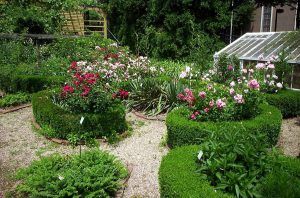
From the early colonial gardens at Stanley-Whitman House to the painterly palette of perennials inspired by the French Impressionists at the Hill-Stead Museum’s Sunken Garden, both in Farmington, much of the flowers and foliage on display at these sites today represent plantings that date back to the gardens’ heydays.
“We try to keep the plants as close as we can to what was there at each garden’s historical peak,” says Laurie Masciandaro, a spokesperson for Connecticut’s Historic Gardens – a consortium of 15 restored properties scattered across the state – and site manager for member Roseland Cottage in Woodstock. Some of the gardens even feature original plantings, like many of the lilacs and heirloom roses that grace the Bellamy-Ferriday estate in Bethlehem, the neatly trimmed boxwoods at Roseland Cottage, and the eponymous Harkness Heliotropes, an antique variety propagated each year from cuttings and then replanted into the East Garden at Harkness Memorial State Park in Waterford.
Each of the properties designated as a Connecticut Historic Garden is associated with an historically significant domicile, so visitors not only get to observe how gardening has evolved over time, but also learn about notable figures from the state’s past – including many influential women – and see how they lived.
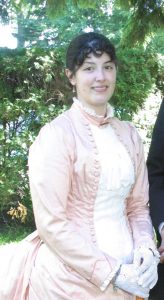
“Women’s history and garden history in Connecticut are intertwined,” says Masciandaro. The women associated with these properties include Florence Griswold, who ran an art colony that nurtured many of the American Impressionists, Theodate Pope Riddle, the country’s first female architect, who designed Hill-Stead, Caroline Ferriday, the prominent socialite and philanthropist behind the Bellamy-Ferriday gardens, who helped survivors of the Nazi camps, Harriet Beecher Stowe, one of the country’s most influential writers, and pioneering landscape architect Beatrix Farrand, one of the first women to break into this then male-dominated field.
Connecticut has a wealth of historic gardens to choose from. Here are some of the highlights in our region:
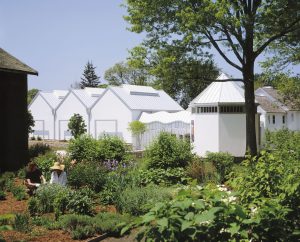
Florence Griswold Museum, Old Lyme
At the turn of the 20th century, Florence Griswold turned her family home into a boarding house, and hosted a group of artists that came to be known as the Lyme Art Colony. Her boarding house became the center of American Impressionism, and her colorful “grandmother-style” garden inspired artists like Childe Hassam and William Chadwick, who were drawn to the property’s bucolic scenery and the quality of the light reflected off the nearby Lieutenant River. In fact, more than 50 years after Griswold’s death, landscape historian Sheila Wertheimer turned to these paintings for guidance when restoring the neglected garden.
Today, as in the late 1800s, masses of old-fashioned flowers like peonies, cosmos and phlox spill from neatly bordered beds in Miss Griswold’s perennial garden, and roses climb the arbor; Swiss chard, chives and sage cohabitate with towering sunflowers in the adjacent vegetable garden; and the works of the artists who once painted here hang in the galleries of the impressionist museum on the grounds. Says Wertheimer, who meets with her volunteer “garden gang” weekly to maintain the garden: “I see photographers and painters there painting the gardens, even today.” FlorenceGriswoldMuseum.org
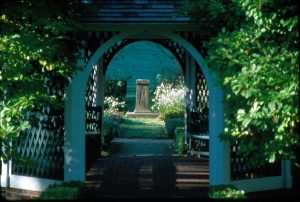
Hill-Stead Museum, Farmington
Miss Griswold’s garden may have inspired artists – but at Hill-Stead, art inspired the garden. The drifts of color along the beautiful garden’s stone walls and brick walks – the blues of verbena, salvia and lavender; pinks of heliotrope, roses and peonies; and whites of cleome, nicotiana and deutzia – reflect the palette of the French Impressionist paintings hanging on the walls of the former country home, not to mention the signature style of famed landscape architect Beatrix Farrand.
After World War I, Theodate Pope Riddle, who designed the Colonial Revival structure in the late 1890s, hired Farrand to update the property’s neo-classical style sunken garden according to her more informal – and artistic – gardening aesthetic. Today, the octagonal garden, which was restored according to plans recovered from an archive of Farrand’s work at the University of California, Berkeley, boasts 36 beds featuring more than 90 varieties of perennials and annuals, and serves as a lovely open-air venue for the Sunken Garden Poetry Festival, an annual celebration of poetry that attracts thousands of visitors each year. hillstead.org
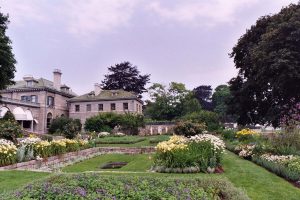
Harkness Memorial State Park, Waterford
Farrand’s hand can also be seen in the magnificent gardens surrounding the Italian Renaissance Classical Revival-style mansion on the shoreline that once belonged to philanthropists Edward and Mary Harkness. “We’ve done the best we can to make it look like it did in 1930,” says garden historian Jeanne Shelburne, who in the 1990s led the restoration of the Harkness gardens using microfilms of Farrand’s original plans, along with old photographs.
Farrand redesigned the more formal West Garden utilizing a palette of yellows, gold and maroon blooms to evoke an Italian sunset, according to Shelburne, and created and installed the East Garden, with its swaths of purplish-blue heliotropes and Asian statuary; the Alpine Rock Garden, with its spectacular bloom of English Bluebells, and the Boxwood Parterre, once known as “Toby’s Garden,” because the family dog is said to have been buried there.
“The scale of Harkness sets it apart from other gardens in our region,” says Shelburne. Indeed, it’s hard not to marvel at the estate’s 200+ acres, replete with fountains, stone walls, wrought iron fencing, and other elegant structures, hundreds of perennials, annuals and shrubs, and sweeping lawns with panoramic views of Long Island Sound. Back in the day, three gardeners worked 12 hours daily to maintain the property; today, a crew of volunteers meets with the head gardener for a few hours every Wednesday morning to help keep the gardens in shape.
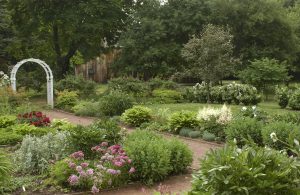
Webb-Deane-Stevens Museum, Wethersfield
Another one of America’s first female landscape architects, Amy Cogswell, designed the Colonial Revival garden behind the 1752 Joseph Webb House, a National Historic Landmark along Wetherfield’s Heritage Walk. With its arched trellises, axial pebbled walkways and beds filled with old-fashioned flowers like roses, hollyhocks, daisies, phlox and oriental lilies, this garden exemplifies this gardening style, in vogue when it was designed in 1921.
Little remained of Cogswell’s original design by the 1990s, but the garden was restored by the National Society of the Colonial Dames of America in Connecticut. Visitors to the garden can also peek into the Webb House, where George Washington once stayed, as well as into two adjacent 18th century houses – the 1769 Silas Deane House, also a National Historic Landmark, and the 1789 Isaac Stevens House. The herb garden just outside the kitchen door of the Stevens home evokes a typical garden from the colonial period, when gardens were less decorative and more utilitarian, featuring herbs like mint, chamomile, lemon balm and thyme for eating and medicinal purposes. webb-deane-stevens.org
Stanley-Whitman House, Farmington
The 1720 Stanley-Whitman House, another National Historic Landmark, offers more insight into colonial gardening. Upon entering the home’s front courtyard, visitors can view raised beds containing examples of plants like hops and dyer’s woad that English settlers, who migrated to Hartford in the 1600s, might have sown in their gardens.
The 18th-century dooryard garden behind the house contains the herbs and vegetables that are known to have been available to colonists, who, during the 1700s, depended on their gardens to provide food, spices, medicines and dyes. Narrow raised beds feature medicinal herbs like catmint, chamomile, and feverfew, aromatic plants like basil, thyme and tarragon for seasoning, small fruits like blueberries, currants and strawberries, and vegetables like corn, beans and squash (known as “the three sisters”). Beyond the dooryard garden is an apple orchard, which supplied the settlers with hard cider, and a giant oak, grown from a seedling of Hartford’s Charter Oak. stanleywhitman.org
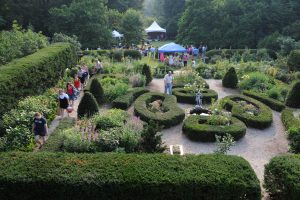
Bellamy-Ferriday House & Garden, Bethlehem
The extensive gardens surrounding the Bellamy-Ferriday House retain elements of the landscape established by Reverend Joseph Bellamy, the leader of the “Grand Awakening” religious revival who built the home in the 1740s. Yet philanthropists Eliza Ferriday and her daughter Caroline, who summered and gardened here beginning in 1912, can be credited with the design and planting of much of what visitors see today.
“The gardens were intentionally planted in such a way that the flowering plants, trees, and shrubs begin blooming in the early spring and continue throughout the summer, so it’s really incredible,” says Sheryl Hack, executive director of Connecticut Landmarks, the non-profit that now owns and maintains the stunning property. Its 10 acres boast an impressive assortment of magnolia trees – which produce the garden’s first blossoms in spring – a colorful Colonial Revival garden, a formal parterre, sweeping lawns, and many specimen trees, including a weeping willow that Caroline Ferriday cultivated using a cutting taken from a tree growing near Napoleon’s grave. “She loved everything French,” notes museum interpreter Gary Cicognani.
The garden also features a notable collection of heirloom roses and lilacs – the latter of which inspired the title of the best-selling novel, Lilac Girls, which tells of how Caroline Ferriday helped the Polish “rabbits” (women who were treated as lab animals by the Nazis) after World War II. The property’s roses may soon become as famous as its lilacs. Martha Hall Kelly’s new book, The Lost Roses, a prequel to Lilac Girls, comes out in April, and the Bellamy-Ferriday House will celebrate its release with a special event on April 13. ctlandmarks.org/bellamy-ferriday
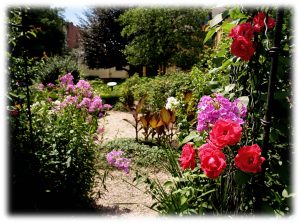
Butler-McCook House, Hartford
The 1782 Butler-McCook House, another Connecticut landmark, is one of only four remaining 18th century buildings in Hartford, says Hack. (One of the others, the Amos Bull House, which serves as the non-profit’s office, sits on the same Main Street property.) The home’s restored Victorian garden, originally installed in 1865, was designed by Jacob Weidenmann, who also designed Bushnell Park; in fact, it is the only surviving domestic commission by the famed landscape architect. Four generations of the McCook family lived in the house and tended its gardens.
A formal garden on the north side of the house features rings of neatly trimmed boxwoods, with more relaxed plantings of colorful flowers like phlox, roses, peonies and iris sprouting cheerfully from their centers, while a more naturalistic garden runs along the property’s south side. A stone bench, birdbath, and stepping stones displayed on the grounds bear inscriptions dating back to the 1940s. “It’s a beautiful oasis right in the middle of Hartford,” says Masciandaro. ctlandmarks.org/butler-mccook
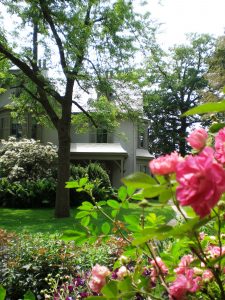
Harriet Beecher Stowe House, Hartford
The property surrounding Harriet Beecher Stowe’s cottage style home in the “Nook Farm” neighborhood, known for the many literary luminaries who resided there (including Stowe’s neighbor Mark Twain), reflects the Uncle Tom Cabin author’s love of gardening. She particularly favored Victorian-era flowers like tulips, roses, dahlias, and daisies, and often collected and displayed bouquets from her gardens in her home. An amateur artist, she also painted her blooms; in fact, some of her floral paintings still hang on the walls of the house today.
Among the eight distinct gardens on her Forest Street property are a woodland garden, a blue cottage garden, a wildflower meadow, a Victorian texture garden, an antique rose garden, and even a “carpet bed,” a fanciful Victorian trend in which flowers were planted to look almost like ornamental rugs on the lawn. One of the state’s largest magnolia trees graces the property, as does a dogwood,
more than 100 years old, that is thought to have been planted while Stowe still lived there. harrietbeecherstowecenter.org
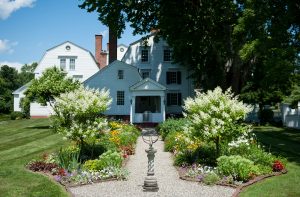
Other notable historic gardens in the state include the Colonial Revival Phelps-Hatheway garden in Suffield, the Hollister House Garden in the Litchfield Hills, which is modeled after a classic English garden and listed on the National Register of Historic Places, and the Gertrude Jekyll Garden at the Glebe House Museum in Woodstock – the only garden designed by the renowned English horticultural designer in this hemisphere. And Elizabeth Park in Hartford, though not associated with an historic home, is the oldest municipally run rose garden in the country, featuring 15,000 plants and 800 varieties of roses.
Connecticut’s Historic Gardens Day, a statewide celebration of historic gardens in which member sites hold special events and activities, will be held on Sunday, June 23 this year, though guests are welcomed at all of the state’s historic gardens throughout the season. “Visiting Connecticut’s historic gardens is a wonderful way to enjoy this state’s incredible and deep history,” notes Hack. “And it’s always good for the soul to get out and enjoy nature.”
Lori Miller Kase is a freelance writer living – and gardening – in Simsbury.
Photography courtesy of Connecticut’s Historic Gardens and Connecticut Landmarks







More Stories
Haunted Apples and Bewitched Beer
Gayle King speaks to Dennis House
Everybody Remembers Their First Outdoor Concert